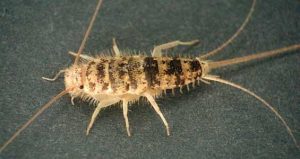 Firebrats are tiny insects with soft brown or grayish bodies that often infest dark secluded areas of your home. These insects feed on foods high in starch, sugar or protein resulting in damage to books, book bindings, wallpapers, cardboard boxes, cereal, clothing and other materials/ items present in your home.
Firebrats are tiny insects with soft brown or grayish bodies that often infest dark secluded areas of your home. These insects feed on foods high in starch, sugar or protein resulting in damage to books, book bindings, wallpapers, cardboard boxes, cereal, clothing and other materials/ items present in your home.
What Do Firebrats Look Like?
Most homeowners will likely never hear of firebrats unless an infestation takes place. You might even see a few of them in moist areas of your home and have trouble identifying who these creatures really are. But once you know them, they are hard to mistake for anything else.
That’s because the bodies of firebrats exhibit very distinct characteristics. The average adult firebrat has a soft, shiny body about ½ inch long with three thin hair-like structures on the bottom tip of its body where the abdomen is located. It is shaped very similarly to a carrot. It also features a pair of antennae on its head.
Firebrats are wingless but able to move quickly due to several pairs of legs that run along its body. Homeowners who are not familiar with firebrats may mistake them for a more common pest, the cockroach.
Where Are Firebrats Most Likely to Infest?
Firebrats are very much like many other pests that may infest your home. They love moisture, dark and secluded places and are nocturnal by nature. That makes several places in your home the ideal habitat if you are not careful. Consider the following areas of your home:
- Closets
What’s hiding in your closet? Let’s hope it’s not a batch of hungry firebrats. To make your closet less attractive to these fiends consider the condition your closets are in. Take for instance moisture levels. You can know if a moisture issue affects your closet if you see signs of mold on your clothing. The darker and more secluded the closet the more attractive it’ll be to firebrats, especially if you store clothing or fabric made of silk, rayon, linen or cotton.
- Attic
Is your attic very humid or cluttered with cardboard boxes, dust, and other material? If this is the case, your attic could be a prime spot for a firebrat infestation. Firebrats are also more likely to choose your attic if it is damp and/or has a temperature of 90° F.
- Kitchen
The kitchen may not seem like the most likely spot for a firebrat infestation. However, be on your guard. The kitchen offers several things firebrats can’t do without, namely food and water.

Kitchen areas need special attention.
They will scurry under counters and in your pantry, attacking food containers, especially food items in containers made of cardboard/ cellulose material, example cereal. Their abdomen contains enzymes which make the digestion of cellulose materials like cardboard an easy task so don’t underestimate these pests.
They may also find home under counters and near kitchen skins where leaks are present. This provides access to water which they need to survive.
- Bathroom
Firebrats don’t mind living in your bathroom. Especially if it is the kind that has leaking pipes. One of the first places you might see them is in your bathtub as they are not good climbers. They sometimes get stuck in bathtubs as they search for moisture or water. They also may make home among insulation near heating pipes. Once sufficient humidity exists, you’ll find them almost anywhere.
- Basement
Now here’s a place firebrats aren’t afraid to go. The basement is ideal based on the fact that it is usually dark and more secluded than other areas within your home. Your basement can also attract these pests if moisture problems are present. Since your heating or A/C equipment may be present in this section of your home, be sure to maintain it as best as possible.
How to Eradicate Firebrat Pests
Firebrat infestation is usually best controlled through the use of a combination of treatments. Homeowners get best results by contacting pest control professionals who are best equipped with tools to combat this problem. Below are some steps you can consider to eradicate firebrats:
- Set sticky traps to detect where firebrats are most prevalent in your home
- Seal cracks and holes near doors and windows to prevent firebrats from entering home
- Lower humidity and temperature in home by using A/C, automated thermostats, fans or dehumidifiers
- Choose pest management techniques via professional pest control experts to ensure successful eradication.

No Comments